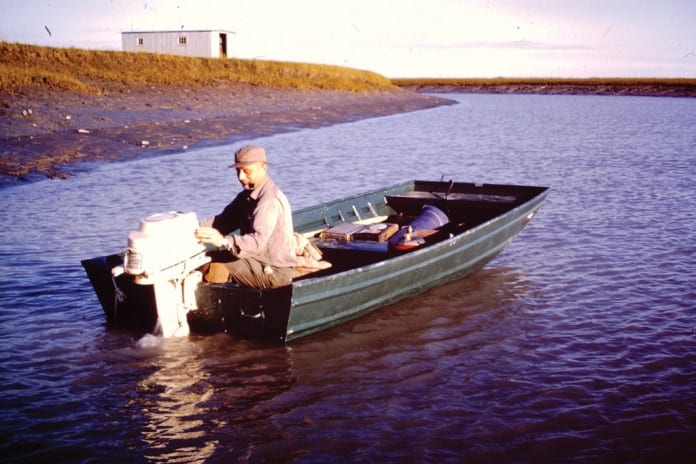
Looking back, it is hard to believe that less than a year after the 1963 fire wiped out much of downtown Cordova, the Good Friday Earthquake on March 27, 1964 dramatically transformed our city and surrounding areas forever. Talk about turbulent times.
Because surrounding islands prevented a huge tsunami, Cordova avoided much of the damage and tragic loss of life that occurred in Valdez, Chenega, and elsewhere. But the uplift of roughly 8 feet left much of the fishing fleet high and dry, and likely was the final blow to a declining razor clam industry.
Ironically, it was this uplift that generated one of the more secret explosions on the Copper River Delta. Fortunately it involved no loss of life, and contained elements of humor well appreciated by a small group of locals.
An early result of the Delta uplift was that some of the best duck ponds drained, and hunters who had built cabins near these marshes were soon staring at dry meadows and empty skies.

Photo by Dick Shellhorn/The Cordova Times
Among them was Dick Borer, who had built a cabin at Little Glacier. Enter Jim Webber, resident Delta Historian Emeritus, who told this tale:
“Somewhere Dick had read an article about using dynamite to create duck ponds down south in the Plains states. It described the process, which was basically dig a narrow deep hole, fill it with dynamite, and then set it off. The sides of the crater would sluff as it filled in with water, creating a nice pond.”
“Dick decided to do it behind his cabin at Glacier. They hauled down loads of dynamite (by airboat, which must have been exciting), but then discovered it was impossible to dig a deep hole down there without it rapidly filling up with water. So the dynamite was left stacked under a tarp at the planned pond location. At some point someone came down and set it off. Not sure how. It didn’t make any pond. But it shifted Borer’s cabin on its pilings. Almost knocked it off. He was really mad. Of course everyone else laughed about it.”
Well, when Jim Webber doesn’t know who did what on the Delta, that is a well kept secret, which I somehow uncovered, while doing research for my book Time and Tide, by promising to keep parts of the story still secret.
Turns out a twosome, a rifle, and an airplane were involved, in some ways amazingly similar to the deadly 1947 explosion at Alaganik, in which LaGasa and Kulper, a 30-06 rifle, and a power boat were key elements.
The modern day pranksters had heard of the stack of dynamite, and landed in a Super Cub equipped with fat tires at what they thought would be a safe distance several hundred yards away. The pilot got out his rifle, and said something like “watch this”. Nothing resulted from his first shot, but the second one caused a huge explosion, much larger than anticipated. It knocked the two of them to the ground. Mud went flying everywhere, and clumps landed on their plane.
A large black cloud arose in the air. Little Glacier is below the Mile 13 airport, and the brush and timber weren’t as tall back then. The pair could actually see the tail of an Alaskan Airlines jet that had just landed. They were certain someone had seen or heard the blast, and it would be reported by the FAA, which might result in a quick response by the Coast Guard or local pilots.
Frantically they scraped the mud off the plane’s wings and windshield, and took off as quickly as they could.
Before returning to Cordova, they flew to Hinchenbrook Island, landed on the beach at Hook Point, taxied to a nearby clear water stream, and gave the plane a thorough wash job.
Perhaps they did Borer a favor, for dynamite, after sitting for a while, can be dangerous to handle.
The ducks? Well, they were probably lying on their backs, kicking their webbed feet in delight, and dying quacking.
As were several Elks members, including many of Borer’s hunting partners. They routinely gathered at the local lodge after work to quaff a few. They had to pass the bank to get there for a B&B. Which stands for a Beer.
And a Blast of a different sort — namely a shot of flinch-inducing whiskey.
Want more Cordova Chronicles? Click here to view the archives.














